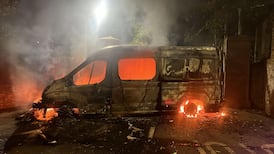London Underground's iconic diagram has inspired an integrated map of Dublin transport routes, writes FRANK McDONALD,Environment Editor
EIGHT YEARS ago, a German-born graphic design student came for the first time to Dublin and was as confused as anyone about how to get around the city by public transport.
There was no handy map of bus and rail services, so it became a “pet project” for Aris Venetikidis (his father is Greek and his mother German) to make one as memorable as the London Underground diagram.
After being rejected initially as a project for his undergraduate degree in graphic design at the National College of Art and Design (NCAD), because his tutors thought it would be “too complex”, he got another chance to do it for his master’s degree. And by then, he had years of experience of using public transport in Dublin.
“I found it frustrating and far below international standards,” he says. “I grew up in the Ruhr Valley region in western Germany, where they have great public transport maps. But when I started using graphic design to produce a map for Dublin, I came to the conclusion that the network itself is so complex that it’s almost unmappable.”
So Venetikidis, who is now 31, teamed up with Dublin Institute of Technology postgraduate and transport campaigner James Leahy, who had finished his master’s degree thesis on bus rapid transit as a sustainable – and more affordable – alternative to Luas. Together, they created a “model network”, which he then began to map.
“After spending about a year drawing maps over and over again, going back to square one and improving them, I ended up with a city centre public transport map, based on a simplified network, that has an unprecedented level of detail and clarity – and this has been acknowledged by Dublin Bus, Dublin City Council and others.
“The reaction to my map has been outstandingly, overwhelmingly positive. There’s still a lot of discourse about James Leahy’s model, but it’s clear to me that, without a fundamental simplification of the network, the system will remain confusing to new users and so will any endeavour to create intelligible public transport maps.”
Essentially, the map Venetikidis designed includes all bus services and stops, as well as existing and proposed Luas stops, existing Dart stations and the proposed Dart Underground link between Inchicore and Docklands, with intervening stations at Heuston, Christ Church, St Stephen’s Green, Pearse (Westland Row) and Spencer Dock.
Everything is colour-coded, and the 10 bus rapid transit lines proposed by Leahy are given names such as Beckett, Larkin, Stoker and Yeats.
These are shown on a large format map of the public transport network as a whole, then in detail on a separate map of the inner city area, so people can see exactly where they are going.
“Every stop is on it, because you can’t assume that every new user has a working knowledge of Dublin’s geography,” Venetikidis says. “So even Dubliners invited to a friend’s party, for example – all they would have to do is to identify the nearest stop on the map, which is not something they can do now, and then work out the route they need to take.”
As the iconic London Underground map had shown, “a successful integrated public transport map is the key to motivating people to leave the car and make the switch to a sustainable transport mode. Couple that with a modern network of rapid transit and you have the solution to congested city centre streets and an absent infrastructure.”
Venetikidis is full of admiration for Harry Beck, the London Transport employee who drew the original diagram of its tube network in 1931 that still forms the basis of the map in use today. With its use of colour coding, spatial distortion and clear lines (like his own Dublin diagram), the underground map is the way most people relate to the layout of London.
“I think we’ve reached a point at which the different players involved in planning public transport in Dublin have realised the importance of simplifying the network,” he says.
“I would hope that eventually they will also strive for true integration, including the long-awaited introduction of an integrated ticketing and fare system.”
The map of such an idealised new world order for Dublin transport, designed by Aris Venetikidis, can be downloaded at www.aris.ie








